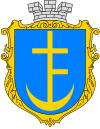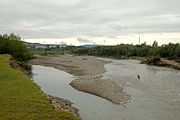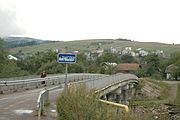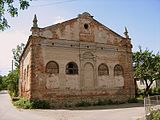Staryi Sambir Старий Самбір | |
|---|---|
City | |
 Main square | |
| Coordinates: 49°26′35″N 23°00′12″E / 49.443056°N 23.003333°E | |
| Country | |
| Oblast | |
| District | |
| First mentioned | 1378 |
| Population (2020) | |
| • Total | 6,531 |
| Time zone | UTC+2 (EET) |
| • Summer (DST) | UTC+3 (EEST) |
Staryi Sambir (Ukrainian: Старий Самбір, Polish: Stary Sambor, Staremiasto, Stare Miasto) is a city in Lviv Oblast of western Ukraine, close to the border with Poland. It is the administrative center of Staryi Sambir Raion (district). Its population is approximately 6,531 (2020 est.)[1].
History
The exact date of establishment of the town is not known. Sambir, known in Polish as Sambor, was for the first time mentioned in documents in 1378. At that time, it was a private town of the noble Herburt family, part of Przemysl Land, Ruthenian Voivodeship, Kingdom of Poland. In 1501, a Roman Catholic church was opened here, and in 1553, Sambir received a town charter. In 1668, a town hall was built here, and in the early 18th century, the local church was remodelled. Until 1772 (see Partitions of Poland), Sambir belonged to Przemysl Land, Ruthenian Voivodeship. From 1772 until late 1918, Sambir belonged to Austrian Galicia. In 1880, its population was 3,482, with 1,399 Greek-Catholics, 704 Roman Catholics, and 1,377 Jews.
During the Polish-Ukrainian War, Sambir was seized by the Poles whose possession of the town was confirmed in the Peace of Riga. According to the 1921 census, the town had a population of 4,314, with 1,534 Jews. In the Second Polish Republic, it was the seat of a county in Lwow Voivodeship (until 1932). After the 1939 invasion of Poland, the town was annexed into the Soviet Union. Its Jewish residents were murdered in the Holocaust.
In the immediate postwar period, the remaining ethnic Poles were expelled.[2] Most of them settled in the Recovered Territories. Ukrainians were resettled following Operation Vistula.
Notable residents
- Mikołaj Zyblikiewicz (1823–1887), Polish politician and lawyer
- Maria Jarema (1908–1958), Polish painter and sculptor
Gallery
References
- ^ "Чисельність наявного населення України (Actual population of Ukraine)" (PDF) (in Ukrainian). State Statistics Service of Ukraine. Retrieved 30 September 2020.
- ^ Jerzy Kochanowski (2001). "Gathering Poles into Poland. Forced Migration from Poland's Former Eastern Territories". In Philipp Ther, Ana Siljak (ed.). Redrawing Nations: Ethnic Cleansing in East-Central Europe, 1944–1948. Lanham: Rowman & Littlefield Publishers. ISBN 978-0-7425-1094-4.
External links
- Staryi Sambir, Ukraine at JewishGen







